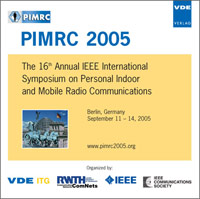On the use of Reed-Solomon codes in Space-Time Coding
Conference: PIMRC 2005 - 16th Annual IEEE International Symposium on Personal Indoor and Mobile Radio Communications
09/11/2005 - 09/14/2005 at Berlin, Germany
Proceedings: PIMRC 2005
Pages: 5Language: englishTyp: PDF
Personal VDE Members are entitled to a 10% discount on this title
Authors:
Lalam, M.; Amis, K.; Leroux, D. (GET-ENST Bretagne, TAMCIC (UMR 2872 CNRS), SC Department, Technopole Brest Iroise, CS 83818 - 29238 Brest Cedex 3, France)
Abstract:
In this paper, we present an original use of Reed-Solomon (RS) codes as Space-Time Block Codes (STBCs) and compare them to orthogonal STBCs (OSTBCs). Due to their symbol structure, they can have a representation close to that of an STBC. RS codes are admittedly more complex to decode as they have no orthogonal properties. However, they offer much higher coding rates. In addition, a wide range of these codes can be easily generated. To decode them, we have developed a new algorithm using a sliding encoding-window (SEW), which is combined with the decoding-based Chase algorithm. We compare the RS(15,7) code to the Alamouti one, both having an equivalent coding rate. Its performance compared to Alamouti gets better as the receive diversity increases. Moreover, RS codes do not require the channel to remain constant over the code duration. In fact, they offer better results if the channel changes rapidly, which can be obtained virtually by introducing interleaving


